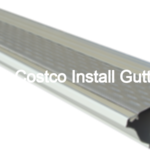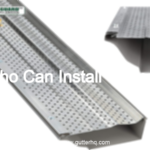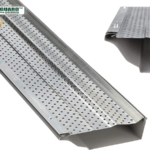There is no one definitive answer to this question as the proper way to install gutters can vary depending on the specific circumstances of the project. However, there are some general tips that can be followed to help ensure a successful installation.
One important tip is to make sure that the gutters are properly supported. This means that they should be securely attached to the fascia board and the rafters. If the gutters are not properly supported, they can sag or even fall off of the house, which can cause serious damage.
Another tip is to make sure that the gutters are installed at the correct pitch. This ensures that water will flow properly through the gutters and not pool in them. If the gutters are not pitched correctly, water can back up in them and cause them to overflow, which can lead to water damage to the house.
Finally, it is important to make sure that the gutters are properly sealed. This helps to prevent leaks and ensures that the gutters will function properly. If the gutters are not sealed correctly, they can allow water to leak through, which can cause serious damage to the house.
How do you tell if gutters are installed correctly?
- Make sure that the gutters are properly pitched. This means that they should slope slightly downwards towards the downspout, so that water can easily drain through.
- Check to see that the gutters are securely attached to the house. They should be bolted or screwed into place so that they don’t come loose over time.
- Inspect the gutters for any leaks or holes. These can be patched up with some caulking or sealant.
- Make sure that the downspouts are properly installed and are not blocked. Leaves and debris can sometimes get caught in them, so it’s important to clear them out regularly.
- Finally, take a look at the overall condition of the gutters. If they’re sagging or pulling away from the house, then they were likely not installed correctly.
Do gutters go over or under drip edge?
The purpose of a drip edge is to control the flow of water off the roof. It is installed along the edges of the roof and extends beyond the edge of the roofing material. Gutters are installed under the drip edge to collect and channel the water away from the building.
Do you install gutters at an angle?
Yes, we install gutters at an angle. This is because gutters are designed to funnel water away from your home, and if they are installed flat, they will not be able to do this effectively. By installing them at an angle, we ensure that they will be able to do their job properly and keep your home safe from water damage.
How far should gutter be from drip edge?
There is no definitive answer to this question as it will depend on the specific circumstances of each individual property. However, as a general rule of thumb, it is generally recommended that gutters should be positioned approximately 3-4 inches away from the drip edge. This will ensure that water can effectively drain away from the edge of the roof and into the gutter system without any issues.
Do you install gutters with fall or level?
The answer is that it depends on the situation. If you are installing gutters on a new home, you will want to install them with fall, so that the water will flow away from the foundation of the house. If you are installing gutters on an existing home, you will want to install them level, so that the water will flow into the gutters evenly.
How do you fix improperly pitched gutters?
- Begin by inspecting your gutters to see if they are properly pitched. If they are not, you will need to adjust them so that they are.
- To adjust your gutters, you will need to loosen the screws that hold them in place.
- Once the screws are loose, you can adjust the gutters so that they are pitched properly.
- After the gutters are pitched properly, you can then tighten the screws to hold them in place.
Is there supposed to be standing water in gutters?
There are a few reasons why standing water might accumulate in your gutters. One possibility is that your gutters are too small for the amount of water that typically falls during a storm. In this case, you might need to install larger gutters or take other measures to ensure that the water has somewhere to go. Another possibility is that there is an obstruction in your gutters that is preventing the water from flowing through. This could be something as simple as leaves or twigs that have accumulated over time, or it could be a more serious problem like a blockage in the downspout. If you suspect that there is an obstruction, you’ll need to clean out your gutters to remove it. Finally, standing water in gutters can also be caused by a leak in the gutter system. If you see water flowing out from under your gutters or notice any other signs of a leak, you’ll need to have the system repaired as soon as possible.
Conclusion
There is no one definitive answer to this question as there are a few different ways to install gutters. However, some tips to keep in mind when installing gutters include making sure that they are properly secured and level, and ensuring that the gutters are the correct size for your home.

















